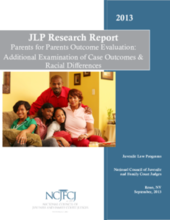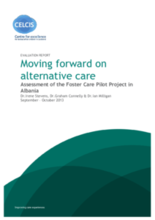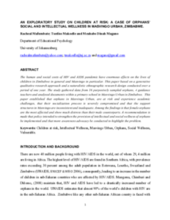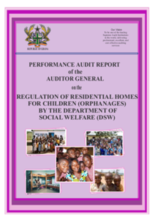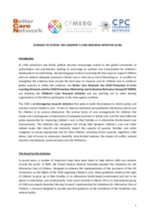Demographic Data
|
Sources: World Bank, UNICEF, UNDP HDR 2015, DHS 2013 |
Displaying 12651 - 12660 of 14580
This paper by the Brookings Center on Children and Families examines the scope of parenting interventions in the US that directly address poor parenting, as research has found how much parenting matters.
This evaluation sought to explore the differences in case outcomes by program participation and racial groups.
This paper presents an evaluation of the pilot foster care project (FCPP) in Albania.
The study gathered data from 16 purposively sampled orphans, 4 guidance teachers and analysed documents within a primary school in Masvingo Urban in Zimbabwe.
This study funded by Big Lottery and undertaken in partnership between the University of Bristol and Buttle UK, a grant-giving charity for vulnerable children, aims to fill gaps in understanding about the experiences of children living with kins, and in particular how children in informal kinship care view their situation.
This audit was conducted to determine whether the Department of Social Welfare in Ghana was sufficiently regulating the operations of Residential Homes for Children (orphanages) to ensure the care and protection of children living in institutions.
It is estimated that about 2 million children around the world are living in institutions, though the true figure may be higher. However, according to this article, the number of institutions globally is in decline.
The well known radio show This American Life has collaborated with Planet Money to investigate the work of a charity called GiveDirectly. Instead of funding schools or wells or livestock, GiveDirectly has decided to just give money directly to the poor people who need it, and let them decide how to spend it.
This concept note from the Better Care Network (BCN), the Child Protection in Crisis Learning Network (CPC Learning Network) and the Child Protection Monitoring and Evaluation Reference Group (CP MERG) calls for the participation of other leading organizations in an inter-agency coalition, the Children’s Care Research Initiative, in an effort to strengthen the evidence base around the best ways to improve care for children and to reinforce global capacity to utilize this evidence.
This report provides a review of two projects: Building a Caring Environment for Children in Burundi (UNICEF), which addresses child care reform and New Generation (IRC) which addresses household economic strengthening and parenting skills.


